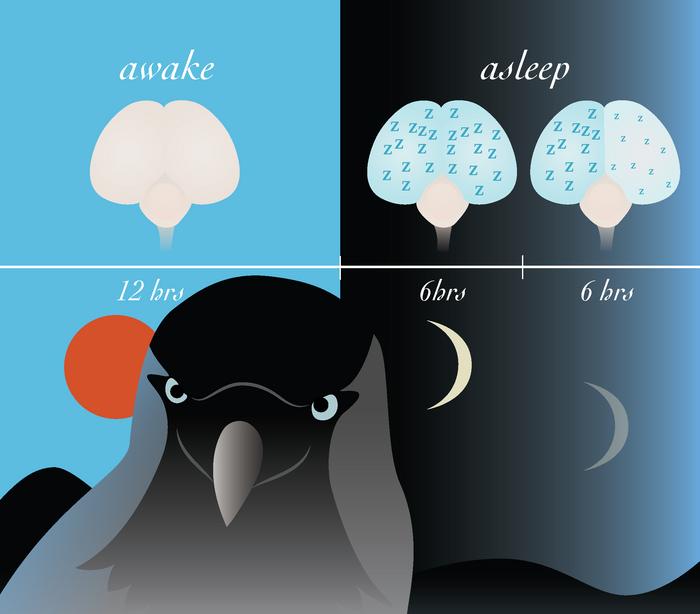As we navigate our increasingly fast-paced world, sleep deprivation can become a familiar adversary. For many of us, pulling an all-nighter leaves us groggy and far from peak performance. Interestingly, birds also experience the effects of sleep loss, reflecting both similarities and differences compared to human responses. Unlike humans, however, birds can employ a unique strategy: they can sleep with one eye open. This adaptation enables them to maintain vigilance against potential threats while still acquiring necessary rest. Recent research focusing on European jackdaws has unveiled a remarkable dimension to this phenomenon, demonstrating that these intelligent birds can sometimes sacrifice vigilance in favor of deeper, symmetrical sleep following periods of deprivation.
The latest study suggests that sleep is a critical component for many species across the animal kingdom. However, the mechanisms and functions of sleep can vary significantly among different creatures. For humans, our sleep cycles consist of various stages, alternating between rapid eye movement (REM) and non-REM sleep roughly every 90 minutes. In birds, the complexities of sleep develop slightly differently. Researchers have shown that birds, including jackdaws, typically enter these sleep stages in shorter, more fragmented bursts. One of the fascinating features of avian sleep is the ability to engage in asymmetric sleep, where one hemisphere of the brain remains alert while the other sleeps deeply. This strategy allows birds to remain aware of their surroundings, effectively balancing the need for rest against environmental threats.
Yet, there is a caveat to this sleep strategy. While birds like jackdaws can function effectively under regular conditions, this study sheds light on their limitations. In situations of significant sleep deprivation, these clever birds tend to prioritize deep, symmetrical sleep over their typical asymmetric patterns, which can increase their vulnerability. This finding is illuminating within the context of understanding sleep’s role in animal behavior and survival mechanisms, revealing a trade-off that begs further exploration.
The balance between vigilance and sleep is a dynamic and sometimes precarious dance for these birds. Previous studies have highlighted how various species, from great frigatebirds to mallard ducks, employ vigilant sleep strategies. These adaptations showcase how birds can maintain alertness in different contexts, whether flying or resting among peers. Even humans exhibit variations in their sleep behavior, often sleeping more lightly with selective brain hemisphere activity when in unfamiliar environments, a behavior that reflects evolutionary adaptations to survive in changing conditions.
This new research employs advanced techniques such as electroencephalograms (EEGs) to monitor brain activities in European jackdaws, enabling researchers to explore how these birds recover from sleep deprivation. Mapping brain activity during sleep provides insights into which areas require deeper rest after use. The findings suggest that certain brain regions responded more intensely to sleep loss. For instance, the visual and decision-making centers displayed stronger signals in response to sleep deprivation. Conversely, memory-related areas exhibited lesser effects, indicating a complex interplay in sleep’s restorative functions across different brain regions.
As the researchers uncovered the intricacies of jackdaws’ sleep strategies, they highlighted a fundamental aspect of sleep—its necessity transcends mere inactivity. Sleep is not simply a passive state but is a vital behavior meticulously shaped by evolution and the demands imposed by the environment. This perspective is crucial in understanding the balance animals must maintain between fulfilling their physiological needs and navigating risks posed by both predators and environmental challenges.
The trade-offs inherent in sleep strategies extend beyond jackdaws. Numerous species adopt varied sleep patterns, creating a spectrum of adaptations designed for survival. These adaptations illuminate how sleep can be viewed as a behavioral response finely tuned by environmental pressures. As scientists continue to delve deeper into how birds and other animals manage sleep and vigilance, we gain valuable insights into sleep’s broader implications for health, behavior, and functionality in humans as well.
The implications of this research are not merely academic; they extend to practical applications in the understanding of sleep disorders and related conditions. By elucidating how different species manage their sleep, we can reflect on the importance of rest for mental and physical health across all living beings. Furthermore, the findings draw attention to the intricacies of cognitive function, linking sleep patterns to overall brain performance.
As we ponder the necessity of sleep in our own lives, birds’ remarkable adaptations offer a unique lens through which we can examine our behaviors. Such studies may inspire future explorations into the nature of sleep, perhaps even guiding innovations in how we address sleep loss and its consequences. The resilience and flexibility observed in avian sleep strategies may ultimately inform our understanding of sleep science and offer new avenues for enhancing sleep hygiene and well-being.
In conclusion, while birds like the European jackdaw may exhibit flexible sleep strategies enabling them to survive in the wild, they too experience limitations under sleep deprivation. As researchers continue to explore this phenomenon, the findings highlight the profound complexity of sleep as a critical behavior defined by evolutionary biology. Each study brings us closer to understanding how sleep affects the brain and behaviors across species, with implications that stretch far beyond the realm of avian life.
Subject of Research: Animals
Article Title: Sleep pressure causes birds to trade asymmetric sleep for symmetric sleep
News Publication Date: 31-Mar-2025
Web References:
References:
Image Credits: MPI for Biological Intelligence/ Julia Kuhl
Keywords: sleep, jackdaws, avian sleep strategies, asymmetric sleep, symmetrical sleep, sleep deprivation, vigilance, brain function, evolutionary biology, sleep research.




